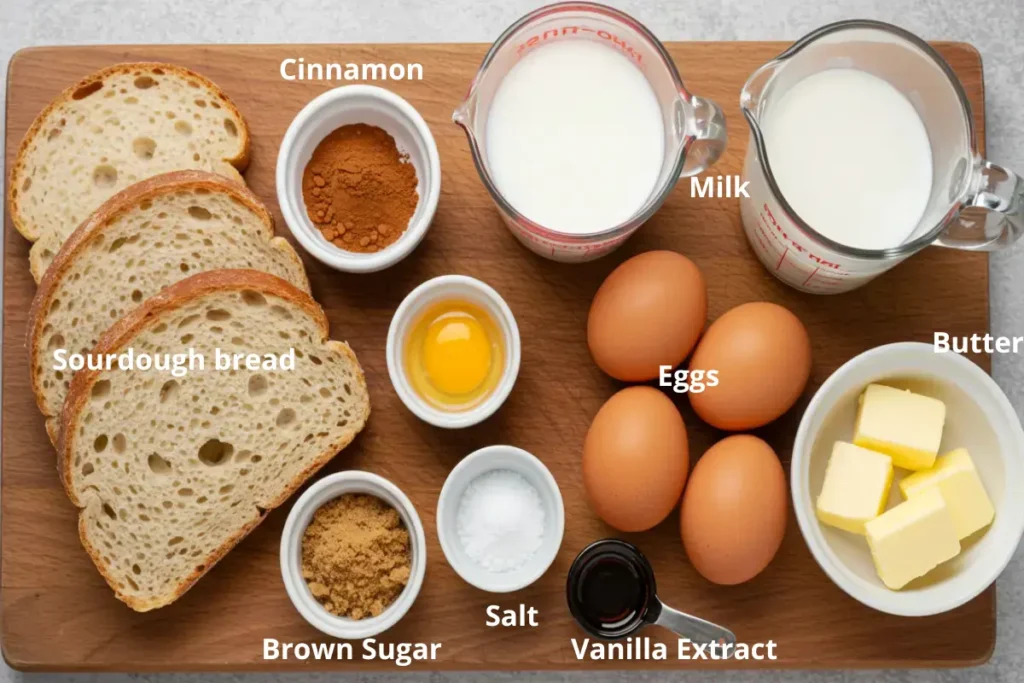Introduction
Sourdough French toast is a delightful twist on the classic breakfast dish, offering a unique combination of tangy flavor and crisp texture that sets it apart from traditional versions. Whether you’re looking for a way to use up leftover sourdough bread or simply want to enjoy a heartier, more flavorful meal, this dish is a perfect choice.
In this guide, we’ll dive deep into everything you need to know about sourdough French toast—from the ingredients you’ll need to expert cooking techniques and delicious variations. Whether you’re a seasoned cook or a beginner, you’ll find helpful tips to elevate your breakfast game.
What is Sourdough French Toast?
Sourdough French toast is a variation of the classic breakfast dish made using sourdough bread instead of regular white or brioche bread. The naturally fermented sourdough brings a tangy, slightly chewy texture that balances perfectly with the sweet and creamy custard mixture used in traditional French toast recipes.
This dish has roots in traditional French cuisine, where leftover or stale bread was repurposed by soaking it in a mixture of eggs and milk before being fried to perfection. Sourdough, with its long fermentation process and distinct flavor, adds an artisanal touch to this age-old favorite.
Key Characteristics of Sourdough French Toast
- Tangy Flavor Profile: The natural fermentation of sourdough creates a unique sour taste that pairs wonderfully with sweet toppings like syrup, honey, or fruit.
- Chewy Texture: Unlike softer breads, sourdough maintains a firm texture even after soaking in the egg mixture, resulting in a crisp exterior and a tender interior.
- Nutritional Benefits: Sourdough is easier to digest than conventional bread, thanks to its fermentation process that helps break down gluten and phytic acid.
- Versatility: It can be made sweet or savory, with endless possibilities for toppings and add-ins.
Why Use Sourdough for French Toast?
Sourdough bread is an excellent choice for French toast, not just because of its distinct flavor but also for its numerous health and culinary advantages.
Health Benefits of Sourdough French Toast
- Easier Digestion: The natural fermentation of sourdough pre-digests gluten and carbohydrates, making it gentler on the stomach.
- Lower Glycemic Index: Sourdough bread has a slower impact on blood sugar levels compared to refined white bread, making it a healthier breakfast option.
- Rich in Nutrients: It contains higher levels of vitamins and minerals such as B vitamins, iron, and magnesium, which are retained better through fermentation.
- Probiotic Potential: While baking kills live cultures, the fermentation process may still contribute to gut health by promoting beneficial bacteria.
Culinary Advantages of Sourdough
- Enhanced Flavor: The mild tanginess balances the sweetness of traditional French toast toppings.
- Better Absorption: Its dense crumb structure soaks up the egg mixture without falling apart.
- Perfect Crispiness: Sourdough develops a golden-brown crust when cooked, giving it an appealing texture.
Ingredients for Sourdough French Toast
To make the perfect sourdough French toast, you’ll need a few basic ingredients.

Essential Ingredients
- Sourdough Bread: Preferably day-old or slightly stale slices for better absorption.
- Eggs: They create the custard mixture that coats the bread.
- Milk or Cream: Adds richness and moisture to the batter.
- Sugar: For a touch of sweetness, typically granulated sugar or brown sugar.
- Vanilla Extract: Enhances the overall flavor profile.
- Cinnamon and Nutmeg: Optional spices that add warmth and depth.
- Butter: For frying and adding richness.
- Salt: Just a pinch to balance the sweetness.
Optional Add-ins
- Orange Zest: Adds a fresh citrus aroma.
- Maple Syrup: For serving or adding to the batter for extra sweetness.
- Liqueurs: Such as rum or Grand Marnier for an adult twist.
- Fresh Berries: For a vibrant and healthy topping.
Step-by-Step Recipe for Sourdough French Toast
Making sourdough French toast is easy and rewarding. Follow these step-by-step instructions for a delicious, golden-brown breakfast treat.
Ingredients:
- 4 slices of sourdough bread (preferably day-old)
- 2 large eggs
- ½ cup whole milk (or dairy-free alternative)
- 1 tablespoon granulated sugar (optional)
- 1 teaspoon vanilla extract
- ½ teaspoon ground cinnamon
- A pinch of salt
- 2 tablespoons butter (for frying)
Instructions:

- Prepare the Egg Mixture:
- In a shallow bowl, whisk together eggs, milk, sugar, vanilla, cinnamon, and salt until fully combined.
- Soak the Sourdough Slices:
- Dip each slice of sourdough bread into the mixture, ensuring both sides are evenly coated but not oversaturated. Let the bread soak for about 20-30 seconds per side.
- Heat the Pan:
- In a non-stick skillet or griddle, melt the butter over medium heat until it starts to bubble.
- Cook the Toast:
- Place the soaked slices onto the pan and cook for 2-3 minutes per side or until golden brown and crispy.
- Serve Warm:
- Transfer to a plate, dust with powdered sugar, and add your favorite toppings like fresh berries, syrup, or honey.
Flavor Variations and Additions
One of the best things about sourdough French toast is its versatility. Whether you prefer sweet or savory, there are countless ways to customize your dish to suit your taste buds.
Sweet Variations
If you have a sweet tooth, consider these delicious ways to enhance your sourdough French toast:
- Classic Cinnamon Sugar:
- Add extra cinnamon and a sprinkle of sugar to the egg mixture for a warm, comforting flavor.
- Top with powdered sugar and a drizzle of maple syrup.
- Berry Bliss:
- Mix fresh or frozen berries like strawberries, blueberries, and raspberries into the batter.
- Serve with a dollop of whipped cream and a dusting of powdered sugar.
- Caramelized Banana and Nut:
- Sauté sliced bananas in butter and brown sugar, then top the toast with caramelized bananas and a sprinkle of chopped pecans or walnuts.
- Chocolate Lover’s Delight:
- Add a touch of cocoa powder to the egg mixture and serve with melted dark chocolate or chocolate chips.
- Pumpkin Spice:
- Add pumpkin puree and spices like cinnamon, nutmeg, and cloves for a fall-inspired treat.
Savory Variations
Sourdough French toast isn’t just for sweet lovers—here are a few savory ideas:
- Herb and Cheese:
- Add grated cheese (such as cheddar or Parmesan) and fresh herbs like parsley or thyme to the egg mixture.
- Serve with sautéed mushrooms or cherry tomatoes.
- Avocado and Egg:
- Top with sliced avocado and a fried or poached egg for a protein-packed breakfast.
- Smoked Salmon and Cream Cheese:
- Spread cream cheese on the toast and top with smoked salmon and capers for a gourmet twist.
- Spicy Jalapeño and Bacon:
- Mix chopped jalapeños into the batter and top with crispy bacon and a drizzle of hot sauce.
Pairing Sourdough French Toast
Pairing your sourdough French toast with the right sides and beverages can elevate your meal to a whole new level.
Best Drinks to Serve
- Coffee: A strong espresso or a creamy latte pairs perfectly with the rich flavors of French toast.
- Fresh Juice: Orange juice, apple cider, or a berry smoothie can add a refreshing balance.
- Herbal Tea: Chamomile, mint, or spiced chai offer a soothing complement to the dish.
Sides to Complement Your Meal
- Fresh Fruit: Sliced oranges, mixed berries, or caramelized apples add a refreshing contrast.
- Yogurt and Granola: A serving of Greek yogurt topped with granola pairs well with the toast.
- Bacon or Sausage: For a heartier meal, add crispy bacon or savory sausage links.
- Hash Browns: Crispy, golden hash browns bring a satisfying crunch to your breakfast plate.
Healthy Substitutions and Dietary Options
If you’re looking for a healthier take on sourdough French toast or have dietary restrictions, there are plenty of alternatives to consider.
Healthier Ingredient Swaps
- Dairy-Free Option: Use almond milk, coconut milk, or oat milk instead of dairy milk.
- Egg-Free Alternative: Substitute eggs with a flaxseed or chia seed mixture (1 tbsp seeds + 3 tbsp water per egg).
- Low-Sugar Version: Reduce sugar or replace it with natural sweeteners like honey or maple syrup.
- Whole Grain Sourdough: Opt for whole grain sourdough for added fiber and nutrients.
Low-Calorie Version
- Use non-stick cooking spray instead of butter to cut down on fat.
- Add mashed banana or unsweetened applesauce to the custard mixture for natural sweetness.
- Serve with fresh fruit instead of syrup.

How to Make Perfect Sourdough French Toast: A Step-by-Step Guide
- Total Time: 25 minutes
- Yield: 2
Description
Indulge in the perfect breakfast treat with this sourdough French toast recipe ! Golden and crisp on the outside, soft on the inside, it’s topped with vibrant fresh berries and a generous drizzle of maple syrup for a delicious start to your day. Served alongside a warm cup of coffee, this dish is a comforting blend of sweetness and tang.
Ingredients
Essential Ingredients
- Sourdough Bread: Preferably day-old or slightly stale slices for better absorption.
- Eggs: They create the custard mixture that coats the bread.
- Milk or Cream: Adds richness and moisture to the batter.
- Sugar: For a touch of sweetness, typically granulated sugar or brown sugar.
- Vanilla Extract: Enhances the overall flavor profile.
- Cinnamon and Nutmeg: Optional spices that add warmth and depth.
- Butter: For frying and adding richness.
- Salt: Just a pinch to balance the sweetness.
Optional Add-ins
- Orange Zest: Adds a fresh citrus aroma.
- Maple Syrup: For serving or adding to the batter for extra sweetness.
- Liqueurs: Such as rum or Grand Marnier for an adult twist.
- Fresh Berries: For a vibrant and healthy topping.
Instructions
- Prepare the Egg Mixture:
- In a shallow bowl, whisk together eggs, milk, sugar, vanilla, cinnamon, and salt until fully combined.
- Soak the Sourdough Slices:
- Dip each slice of sourdough bread into the mixture, ensuring both sides are evenly coated but not oversaturated. Let the bread soak for about 20-30 seconds per side.
- Heat the Pan:
- In a non-stick skillet or griddle, melt the butter over medium heat until it starts to bubble.
- Cook the Toast:
- Place the soaked slices onto the pan and cook for 2-3 minutes per side or until golden brown and crispy.
- Serve Warm:
- Transfer to a plate, dust with powdered sugar, and add your favorite toppings like fresh berries, syrup, or honey.
- Prep Time: 10 minutes
- Cook Time: 15 minutes
- Category: Breakfast
- Method: Baking
- Cuisine: french
Common Mistakes to Avoid
Even though sourdough French toast is simple to make, there are a few common mistakes that can affect the texture and taste. Avoid these pitfalls to ensure perfect results every time.
1. Using Bread That’s Too Fresh
- Why it’s a problem: Fresh sourdough bread tends to absorb too much custard, leading to a soggy texture.
- Solution: Use day-old or slightly stale bread to get the best texture. If your bread is fresh, try lightly toasting it before soaking.
2. Over-Soaking the Bread
- Why it’s a problem: Soaking the bread for too long can make it overly saturated, resulting in mushy toast.
- Solution: Soak the bread for about 20-30 seconds per side, just enough to absorb the mixture without becoming too soft.
3. Cooking at the Wrong Temperature
- Why it’s a problem: Cooking at too high a heat can burn the outside while leaving the inside undercooked. Too low heat results in soggy toast.
- Solution: Cook over medium heat to ensure even cooking with a golden-brown crust.
4. Not Whisking the Custard Mixture Properly
- Why it’s a problem: Inconsistent mixing can lead to uneven flavors and textures.
- Solution: Whisk eggs, milk, and spices thoroughly to ensure a smooth, well-blended custard.
5. Skimping on Butter
- Why it’s a problem: Cooking without enough butter can result in dry or unevenly browned toast.
- Solution: Use a good amount of butter for a rich flavor and crispy texture. Alternatively, use coconut oil for a dairy-free option.
Serving and Presentation Tips
Presentation is key when serving sourdough French toast, whether for a family breakfast or a special brunch gathering. Here are a few ways to make your dish look as good as it tastes.
Plating Ideas
- Stacking: Neatly stack slices on top of each other, drizzle syrup in a zigzag pattern, and top with fresh fruit.
- Dusting: Lightly dust with powdered sugar for a classic touch.
- Garnishing: Add a sprig of mint, edible flowers, or chopped nuts for an elegant touch.
- Side Arrangements: Arrange fruit, yogurt, or a scoop of whipped cream beside the toast for a balanced look.
Creative Toppings
- Whipped Cream and Chocolate Shavings: Perfect for a dessert-inspired French toast.
- Maple Syrup and Candied Nuts: Adds a sweet and crunchy element.
- Greek Yogurt and Honey: A healthier yet indulgent topping.
- Lemon Zest and Berries: Provides a fresh and tangy contrast.
Storing and Reheating Sourdough French Toast
If you have leftovers or want to prepare in advance, proper storage and reheating techniques will help maintain the flavor and texture.
How to Store
- Refrigeration: Store leftover French toast in an airtight container for up to 3 days.
- Freezing: Wrap slices individually in parchment paper and store in a freezer-safe bag for up to 2 months.
How to Reheat
- Oven Method (Best): Preheat the oven to 350°F (175°C), place toast on a baking sheet, and heat for 10 minutes until warmed through and crispy.
- Toaster or Air Fryer: Reheat slices in a toaster or air fryer at medium heat for 3-5 minutes.
- Microwave (Quickest): Use short bursts of 20-30 seconds, though this may soften the toast.
Tip: Add a touch of butter before reheating to restore the crispy exterior.
Nutritional Information
Sourdough French toast is not only delicious but can also be part of a balanced diet when enjoyed in moderation. Here’s a breakdown of the typical nutrition per serving (without toppings):
| Nutrient | Amount (Per Serving) |
| Calories | 250-300 kcal |
| Carbohydrates | 35-40 g |
| Protein | 10-12 g |
| Fat | 8-12 g |
| Fiber | 2-4 g |
| Sugar | 8-12 g |
Note: Nutritional values may vary based on ingredients used and portion sizes.
Frequently Asked Questions (FAQs)
1. Can I make sourdough French toast ahead of time?
Yes! You can prepare and store it in the fridge or freezer, then reheat using the oven or toaster for a quick breakfast option.
2. How do I prevent my French toast from becoming soggy?
Use day-old sourdough bread, avoid oversoaking, and cook on medium heat for even crisping.
3. What’s the best way to reheat leftover sourdough French toast?
The oven or toaster is the best option to restore crispiness while keeping the inside soft.
4. Can I make a dairy-free version of sourdough French toast?
Absolutely! Substitute dairy milk with almond, oat, or coconut milk and use coconut oil instead of butter.
5. Is sourdough French toast healthier than regular French toast?
Yes, sourdough contains probiotics and has a lower glycemic index, making it easier to digest and more nutritious.
6. Can I make a savory version of sourdough French toast?
Definitely! Try adding cheese, herbs, and spices to the egg mixture and pair with savory toppings like avocado or smoked salmon.
Conclusion
Sourdough French toast is a delicious and versatile breakfast option that combines the rich, tangy flavor of sourdough with the comforting, custardy goodness of classic French toast. Whether you prefer it sweet or savory, there are endless ways to customize this dish to fit your tastes.
By choosing the right sourdough bread, using the proper cooking techniques, and experimenting with flavors and toppings, you can create a breakfast masterpiece that’s both satisfying and nutritious.
So, grab a loaf of sourdough and start cooking up a delicious plate of French toast that will delight your taste buds and impress your family and friends !
You may also like :
How to Make the Perfect Kefir Sheet Cake: Step-by-Step Guide
Pesto Langostino Zucchini and Pasta Recipes: The Ultimate Guide to a Flavorful meal


1 thought on “How to Make Perfect Sourdough French Toast: A Step-by-Step Guide”